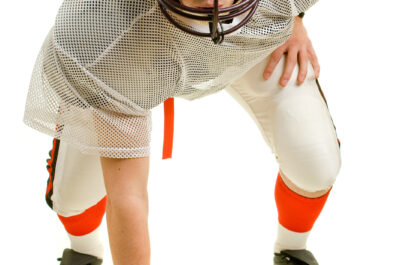New guidelines have been released by the American Academy of Neurology  concerning sports concussions and when a player can be released. Previously the guidelines tried to classify the severity of concussions at the time they occurred and then based return-to-play recommendations on that initial classification. [1] The problem that was discovered through evidence based research was that these guidelines were not good indicators of how long it took a player to recover. The new guidelines will move away from scales, and the emphasis will be placed on an individualized assessment of the concussion, and then individualized management and return to play.
concerning sports concussions and when a player can be released. Previously the guidelines tried to classify the severity of concussions at the time they occurred and then based return-to-play recommendations on that initial classification. [1] The problem that was discovered through evidence based research was that these guidelines were not good indicators of how long it took a player to recover. The new guidelines will move away from scales, and the emphasis will be placed on an individualized assessment of the concussion, and then individualized management and return to play.
“The guideline is endorsed by the National Football League Players Association, the American Football Coaches Association, the Child Neurology Society, the National Association of Emergency Medical Service Physicians, the National Association of School Psychologists, the National Athletic Trainers Association, and the Neurocritical Care Society.”[2]
For the new guidelines literature from 1955 to June 2012 was used and evidence was assessed using a modified Grading of Recommendations Assessment, Development and Evaluation process. A major change was that the new guidelines were developed using a panel of experts comprised of professionals from physical medicine rehabilitation, neurosurgery, and primary care sports medicine. The committee focused on four questions; 1) What factors increase/decrease concussion risk? 2) What diagnostic tools identify those with concussion and those at increased risk for severe/prolonged early impairments, neurologic catastrophe, or chronic neurobehavioral impairment? 3) What clinical factors identify those at increased risk for severe/prolonged early postconcussion impairments, neurologic catastrophe, recurrent concussions, or chronic neurobehavioral impairment? 4) What interventions enhance recovery, reduce recurrent concussion risk, or diminish long-term sequelae? [3]
The new guidelines recommend that a player should not return until they have been assessed by a licensed healthcare professional “with training both in the diagnosis and management of concussion and in the recognition of more severe traumatic brain injury (TBI) (Level B). In addition the recommendations also suggest that athletes of high school age and younger with a concussion need to be managed more conservatively with regard to return to play.
Other recommendations include the following:
- Specific risk factors can increase or decrease concussion risk.
- Diagnostic tools to help identify individuals with concussion include graded symptom checklists, the Standardized Assessment of Concussion, neuropsychological assessments, and the Balance Error Scoring System.
- Ongoing clinical symptoms, concussion history, and younger age identify those at risk for post concussion impairments.
- Risk factors for recurrent concussion include history of multiple concussions, particularly within 10 days after initial concussion.
- Risk factors for chronic neurobehavioral a impairment include concussion exposure and APOEe4 genotype.
- Data are insufficient to show that any intervention enhances recovery or diminishes long-term sequelae postconcussion.
- Practice recommendations are presented for preparticipation counseling, management of suspected concussion, and management of diagnosed concussion.[4]
The study found that estimates of sports-related mild traumatic brain injury (mTBI) range from 1.6 to 3.8 million affected individuals annually in the United States, many of whom do not obtain immediate medical attention.
The new guidelines address the following questions concerning concussions:
- For athletes, what factors increase or decrease concussion risk?
- For athletes suspected of having sustained concussion, what diagnostic tools are useful in identifying those with concussion?
- For athletes suspected of having sustained concussion, what diagnostic tools are useful in identifying those at increased risk for severe or prolonged early impairments, neurologic catastrophe, or chronic neurobehavioral impairment?
- For athletes with concussion, what clinical factors are useful in identifying those at increased risk for severe or prolonged early postconcussion impairments, neurologic catastrophe, recurrent concussions, or chronic neurobehavioral impairment?
- For athletes with concussion, what interventions enhance recovery, reduce the risk of recurrent concussion, or diminish long-term sequelae?
The committee wrote that diagnostic tools may potentially be used to identify athletes with concussion-related early impairments, sports-related neurologic catastrophes (e.g., subdural hematoma), or chronic neurobehavioral impairments. There were no studies found relevant to prediction of sports related neurologic catastrophe or chronic neurobehavioral impairment. The committee also wrote that school based professionals needed to be trained by their licensed health care provider designated by their organization/institution to understand the risks of experiencing a concussion so that they may provide accurate information to parents and athletes. A second recommendation was that Licensed Health Care Providers (LHCP) should inform athletes (and where appropriate, the athletes families) of evidence concerning the concussion risk factors. Accurate information regarding concussion risks also should be disseminated to school systems and sports authorities.
- The recommendations also suggested that LHCPs might refer professional athletes with a history of multiple concussions and subjective persistent neurobehavioral impairments for neurologic and neuropsychological assessment (Level C).
- LCHP’s caring for amateur athletes with a history of multiple concussions and subjective persistent neurobehavioral impairments might use formal neurologic/cognitive assessment to help guide retirement-from-play decisions (Level C)
For more information concerning the study please see the link below or the issue of the American Academy of Neurology for May 18th, 2013.
[1] Jeffrey, Susan AAN Releases New Sports Concussion Guidelines. March 18 Medline News
[2] Ibid
[3] Giza, Christopher, C. M.D. and others Summary of evidence based guideline update: Evaluation and management of concussion in Sports. American Academy of Neurology, March 18th 2013. 0.1212/WNL.0b013e31828d57dd
http://neurology.org/content/early/2013/03/15/WNL.0b013e31828d57dd.full.pdf+html
[4] Ibid (Giza)


